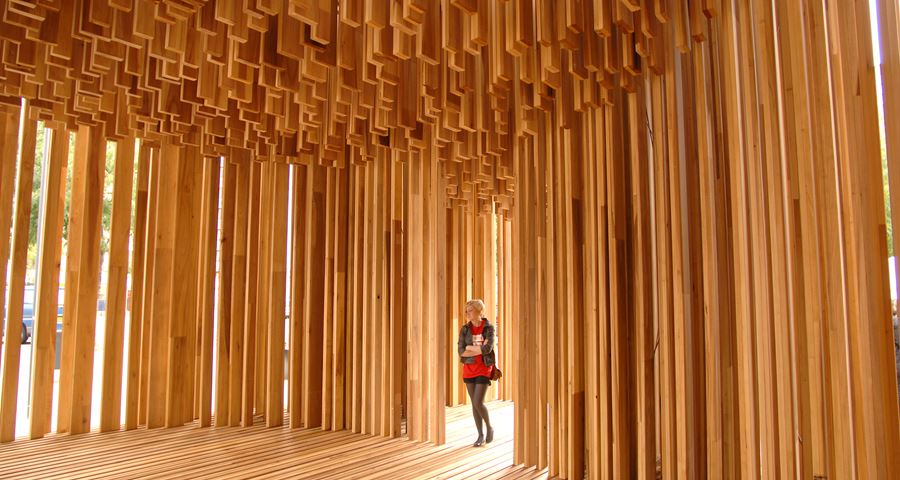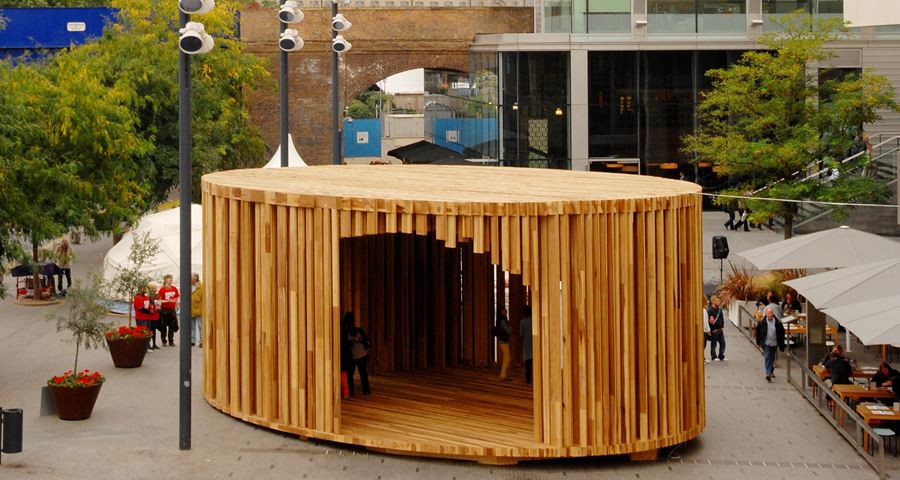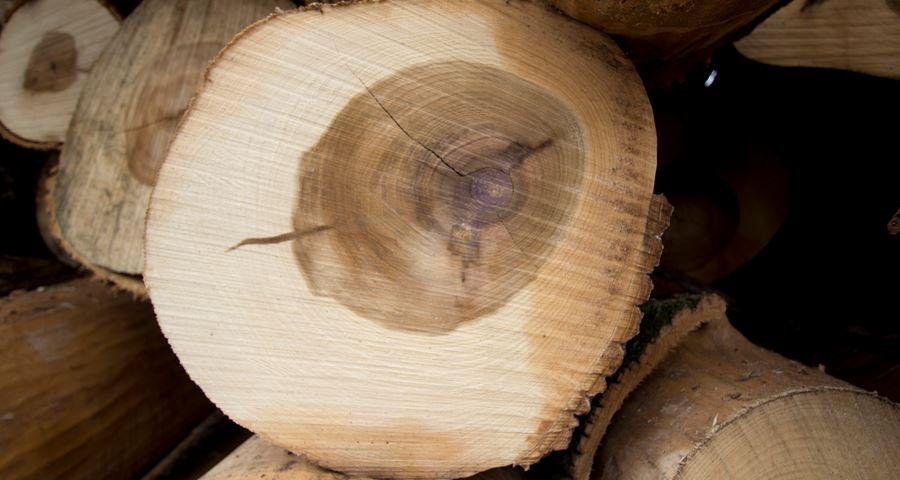David Adjaye: Making Memory
Q&A with David Venables, European Director - AHEC
This elliptical wooden outdoor pavilion commissioned by American Hardwood Export Council (AHEC) was located near the Thames during the London Design Festival 2008. Crafted from American tulipwood by Adjaye Associates, the structure invites visitors to walk the full length of the pavilion. AHEC, with the help of renowned UK workshop Bechmark, will be re-creating a part of the pavilion once again for the Design Museum’s exhibition David Adjaye: Making Memory, which opens on 2 February 2019.
Ahead of the show, the Design Museum caught up with AHEC’s European Director, David Venables.

Sclera, Adjaye Associates. Image by Leonardo Finotti.
Q:Can you tell us a little bit about yourselves?
The American Hardwood Export Council is a creative marketing organisation that represents raw material producers from the American Hardwood industry. Its global programme, which is supported both by the industry and the U.S. Department of Agriculture (USDA), educates, informs and inspires wood industries and design professionals about all aspects of American hardwoods.
AHEC have been active in Europe for nearly 30 years and have developed a unique and innovative approach to creative wood marketing, a key part of which, during the last 10 years, has been experimental collaborations with leading architects and designers. The importance of Sclera for AHEC was that it was the first collaboration of this type and the first time that American tulipwood had ever been used structurally. It also marked the beginning of AHEC’s relationship with the London Design Festival.
Q: What was your vision for Sclera?
The vision for Sclera came from the architect. We saw the collaboration as an opportunity to encourage the design team to do something unusual, experimental and innovative with a sustainable American hardwood they hadn’t used before.

Q: What was the first conversation you had with your team, which brought about your idea for Sclera and how did your collaboration with David Adjaye come about?
This whole collaboration came about because we were approached by the London Design Festival, to be part of their creative projects programme, where they matched different materials with leading architects.
At the first meeting we took along a sample set of the 20-commercial species of U.S. hardwood, which we had created for a previous campaign as handcrafted wine bottles, a clever way of showing the grain colour and character of each timber. They provided the catalyst for an interesting conversation about the sustainability, merits and history of the different species. We were keen that David and his team had the choice as to which timber they wanted to work with.
Q:The pavilion is crafted from American tulipwood, what are its unique properties and why was this Adjaye’s preferred species?
At that first meeting, when we told David that tulipwood was the least expensive of our hardwoods, accounted for 9% of the total hardwood resource in the U.S., and was often painted or used as a moulding or framing timber, but that we had discovered it had incredible strength for its weight, he was very interested and wanted to know more. And so began the journey to explore the structural and aesthetic potential of American tulipwood.
David’s idea for the pavilion was made possible by the fact that we had detailed strength data on American tulipwood, which had been collected during a testing project years earlier at the BRE (Building Research Establishment). This data was used by the fabricators Hess Timber to engineer and make the structure. As well as its strength, we believed that its distinct marble-like colour made it visually exciting and David agreed with us. This response was very much in contrast to how it was seen at the time by wood industries who saw its colour variations as a disadvantage! David designed a structure with it, leaving all its dramatic colour and grain exposed. We also turned Sclera into a research project; we carried out market research with the many visitors to ascertain their reaction. The project achieved huge global publicity and was the beginning of a change in attitude towards this important timber.

Q: How does American tulipwood ensure Sclera is a low carbon piece of design?
Wood is unique as a construction material, because it is both renewable and acts as a carbon stores, stopping it from being released into the atmosphere. At the time of Sclera, we didn’t have the detailed information on Life Cycle and the Environmental Impacts of working with it that we now have.
We always knew that working with wood, including hardwoods like tulipwood, has a much more positive environmental impact than working with other materials. Around that time, we started detailed research programmes into the environmental life-cycle of all American hardwoods.
Q: How did you ensure the wooden structure was weatherproof and what other factors did you have to take into consideration due to its proximity to the River Thames?
There was no issue with the proximity to the river. The big challenge was that David chose to use a non-durable timber for an exterior structure. At the time we were very clear that this could not be a permanent solution, however we were able to work with the specialist wood treatment company Osmose and use one of their protective oil finishes containing a biocide. That gave the structure enough protection against rain and moisture for the four weeks it was up.
Since that time, new technologies have become available such as ‘thermal modification’, which does not use any chemicals – this means that tulipwood can now be used permanently outside and we are now seeing examples where this has happened, the most well-known being drmm’s Maggies Centre in Oldham.

Q: As a monument, Sclera is meant to reflect history, memory and record human lives. How does the building’s unique design encourage this?
One of the exciting things about Sclera for us is that it showed us the potential of a new type of communication about materials, because here was a chance to work closely with a well-known and brilliant architect to present our material in an extraordinary way that enabled us to engage designers and the design media all over the world, in a way we hadn’t been able to do before. But it also was the first time we had created something in a public space. It was that interaction and seeing thousands of people engage with the structure, spend time in it, and explore and appreciate it, that was so rewarding and exciting for us, that made us want to do it again. We have done these many times now with amazing architects and designers, but each time we do a structural installation, we start with an important message that we want to communicate and we use it as an opportunity to innovate. We will always be grateful to David and the London Design Festival, and to the creation of Sclera. It has given us a lot of pleasure to revisit the project and work with Adjaye Associates and Benchmark Furniture (whose specialist craftsmen have helped make the installation for the exhibition), to re-engage the public with those messages once again, ten years later. And to be able to do that in the extraordinary new Design Museum, makes it all even more special.
Q: You are currently in the process of creating a section of the pavilion for David Adjaye: Making Memory at the Design Museum (opening 2 February). What’s the one thing you’d like people to remember about this project when they leave the exhibition?
These opportunities to engage designers and the public about what can be done with wood is even more relevant today than it was when Sclera was first made. Wood and, particularly high-performance hardwoods like tulipwood, have a very important role in future building and product design. What other material can please, excite, achieve and at the same time play a positive environmental contribution to climate change? Timber it is the material of today and an exceptional material for tomorrow – if that key message reaches more people during this exhibition, then that is a really good thing.
Related exhibition